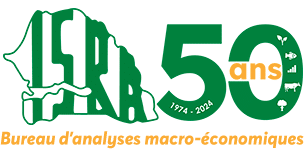Publications dans des revues
Liste des publications à télécharger des chercheurs du BAME dans des revues scientifiques
Documents joints
-
 Strengthening Women’s Empowerment, Climate Resilience, and Nutrition Along the Goat Value Chain in Senegal, A qualitative study
P. A. KANE et al. / In IFPRI Discussion Paper N°02274, Septembre 2024
Strengthening Women’s Empowerment, Climate Resilience, and Nutrition Along the Goat Value Chain in Senegal, A qualitative study
P. A. KANE et al. / In IFPRI Discussion Paper N°02274, Septembre 2024 -
 Multi-criteria analysis of adoption paths for fertiliser resource optimisation technologies
M. G. FALL et al. / Int. J. Biol. Chem. Sci. 18(3): 882-893, 2024
Multi-criteria analysis of adoption paths for fertiliser resource optimisation technologies
M. G. FALL et al. / Int. J. Biol. Chem. Sci. 18(3): 882-893, 2024 -
 The impact of access to agricultural advisory services on input use and farm performance : Evidence from Senegal
Ricome, A., Faye, A., Fall, C. S., & Gomez‐y‐Paloma, S. In Agribusiness, 1–19, (2024)
The impact of access to agricultural advisory services on input use and farm performance : Evidence from Senegal
Ricome, A., Faye, A., Fall, C. S., & Gomez‐y‐Paloma, S. In Agribusiness, 1–19, (2024) -
 Peste des Petits Ruminants (PPR) Vaccination Cost Estimates in Burkina Faso
Ilboudo, G.S.; Kane, P.A.; Kotchofa, P.; Okoth, E.; Maiga, A.; Dione, M. Peste des Petits Ruminants (PPR) Vaccination Cost Estimates in Burkina Faso. Animals 2022, 12, 2152.
Peste des Petits Ruminants (PPR) Vaccination Cost Estimates in Burkina Faso
Ilboudo, G.S.; Kane, P.A.; Kotchofa, P.; Okoth, E.; Maiga, A.; Dione, M. Peste des Petits Ruminants (PPR) Vaccination Cost Estimates in Burkina Faso. Animals 2022, 12, 2152. -
 Socio-Economic Constraints of Adopting New Cowpea Varieties in Three Agro-Ecological Zones in the Senegalese Peanut Basin
Beye, A.; Diakhate, P.B.; Diouf, O.; Faye, A.; Obour, A.K.; Stewart, Z.P.; Assefa, Y.; Min, D.; Prasad, P.V.V. Socio-Economic Constraints of Adopting New Cowpea Varieties in Three Agro-Ecological Zones in the Senegalese Peanut Basin. Sustainability 2022, 14, 14550.
Socio-Economic Constraints of Adopting New Cowpea Varieties in Three Agro-Ecological Zones in the Senegalese Peanut Basin
Beye, A.; Diakhate, P.B.; Diouf, O.; Faye, A.; Obour, A.K.; Stewart, Z.P.; Assefa, Y.; Min, D.; Prasad, P.V.V. Socio-Economic Constraints of Adopting New Cowpea Varieties in Three Agro-Ecological Zones in the Senegalese Peanut Basin. Sustainability 2022, 14, 14550. -
La régulation du marché de l’oignon au Sénégal
Wade, Idrissa; Ndiaye, Oumar Samba. In Grain sel n° 48 (p8), 15 décembre 2009. -
Les systèmes de collecte du lait en Afrique de l’Ouest : échec ou espoir ?
Dia, Djiby; Broutin, Cécile Duteurtre, Guillaume. In Grain de sel nº 46-47, (partie 18- 19p), mars-août 2009. -
Les ressorts internes de l’autonomie alimentaire des groupes familiaux du Bassin arachidier Sénégalais.
JIMBIRA, Maam Suwadu- SAKHO; BIGNEBAT, Céline; SOUBEYRAN, Raphaël; CATTIN, Michel BENOIT. Les ressorts internes de l’autonomie alimentaire des groupes familiaux du Bassin arachidier Sénégalais. 2ème Journées INRA-SFER-CIRAD de Recherches en Sciences Sociales 11- 12 Décembre 2008, Lille, FRANCE, 24P. -
Local diversification of income sources versus migration:Complements or Substitutes ? A case study from rural Senegal.
Jimbira, Maam Suwadu -Sakho; BIGNEBAT, Céline. Local diversification of income sources versus migration:Complements or Substitutes? A case study from rural Senegal. Paper presented at the 37th Australian Conference of Economists September 30 - October 3, 2008 (Gold Coast, Queensland, Austalia), 19P. -
Cereal supplies in rural families of the Senegalese Groundnut Basin.
Jimbira, Maam Suwadu- Sakho; Cattin, Michel- Benoit. Cereal supplies in rural families of the Senegalese Groundnut Basin. Paper prepared for presentation at the 106th seminar of the EAAE Pro-poor development in low income countries: Food, agriculture, trade, and environment 25-27 October 2007 – Montpellier, France, 19P. -
L’évolution des marchés de bovins au Mali face à la crise ivoirienne/ Trends of the bovine market in Mali within the context of the Ivory Coast crisis
Alary, V.; Poccard-CHAPUIS R.; Dieye, P. Nouhine; Corniaux, C; Dicko. M. L’évolution des marchés de bovins au Mali face à la crise ivoirienne/ Trends of the bovine market in Mali within the context of the Ivory Coast crisis, in Renc. Rech. Ruminants, 1P, 2007. -
Alternative Forecasting Techniques for Vegetable Prices in Senegal
Dieng, Alioune. Alternative Forecasting Techniques for Vegetable Prices in Senegal, in Revue sénégalaise agricole et agroalimentaire, vol.1, n° 3, janvier 2009. -
Régulation des marchés agricoles au sénégal:entre arbitrage et gestion concertée
Duteurtre, Guillaume; Wade, Idrissa; Fall, A.A. Régulation des marchés agricoles au sénégal: entre arbitrage et gestion concertée, in grain de sel n° 41- 42 (partie 2), décembre 2007 -
Les politiques agricoles en Afrique subsaharienne : une symphonie inachevée
Dieye, P.N. Les politiques agricoles en Afrique subsaharienne: une symphonie inachevée. In grain de sel n° 41- 42 (partie 1), décembre 2007, 2p.

